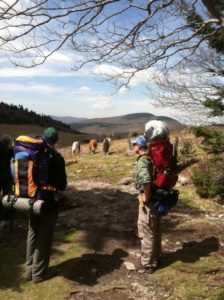
Even before the talk began I realized I had a live one on the line.
I was at the King Public Library Tuesday evening for a presentation on backpacking, a presentation tied to my book, “Backpacking North Carolina.” On the surface, the book is a guide to 43 places to backpack in the state. But it’s true intent is to debunk the backpacking stereotype: of an arduous pursuit best left to survivalists and folks with a high threshold for discomfort.
My first mark was about my age and had backpacked in the ‘70s, mostly in the Smokies. “I especially loved winter camping,” he told me. “No bugs.” But then he started having back problems and drifted from the pursuit.
Back problems. I saw an opening.
“Did you have an external frame pack?” I asked. Sure did. An ungainly thing whose aluminum frame was constantly jabbing him in the ribs and back.
“Try this on,” I said, helping him slip on my pack, which I’d brought as a visual aid. I’ve got a year-old Osprey Aether and it’s a good representation of modern backpack technology. It’s got a lightweight, non-jabbing, alloy frame; multiple adjustment straps to get the fit just right; comes in various sizes; and, has a hip belt that’s heat-molded to the wearer’s body. Packed correctly, it’s more appendage than awkward appurtenance.
“Wow,” he said. “That’s a lot different.” He hadn’t even buckled the belt.
“A lot easier on your back,” I pointed out. “One other thing that will help your back, as well as your knees and legs, are hiking poles.” I detected a slight knee-jerk, I’m-not-an-old-man grimace.
“Seriously,” I continued, “when I started reporting this book I’d come home from trips, my knees would be swollen and I’d hobble around for a week. So I relented and got hiking poles. They made a huge difference for my knees and I probably hiked about a half mile an hour faster.” All true.
My second challenge of the evening was an avid hiker and car camper. But when it came to backpacking, “I just don’t like walking with all that weight on my back,” she said. A perfect segue for why I wrote the book.
“I was reluctant to write this book at first because I didn’t think I was the right person for it,” I explained. “I wasn’t an epic backpacker. I hadn’t thru-hiked the AT, hadn’t really done much more than four-day trips. But then I got to thinking that those missing qualifications were what, in fact, made me a good choice for writing a backpacking guide. The more I talked to fellow hikers and occasional backpackers, the more I realized they didn’t like tromping around with all that weight, either.
“So I ended up writing a book based largely on the base camp concept: Backpack in four, five, six miles, set up base camp, do day hikes from there.”
A distant look settled over her face. “I might like that,” she said.
I can’t really count a third, younger member of the audience as a convert; he was about to enter grad school at Western Carolina in part because of its Cullowhee location, smack in the middle of the Southern App action. He was already planning a trip or two, but I could tell his enthusiasm level rose considerably when I started talking about how technology has helped take the sacrifice out of backpacking. From my kitchen bag I pulled my JetBoil, a gas stove that boils water in less than two minutes; a freeze-dried dinner (beef stroganoff), which I told them was surprisingly good; my beloved instant oatmeal, which mixed with brown sugar and almonds makes a great trail breakfast.
“And this,” I said sticking my hand back into the kitchen stack for a slow, teasing reveal, is my most cherished piece of equipment. “It looks like just an insulated plastic coffee mug, but watch this” — and here I pulled the lid off to reveal a screened trap on a plunger — “it’s a French press! Makes the best trail coffee ever.”
Afterward, the Catamount-to-be came up, his eyes big. “I’m really excited about that French press,” he said. “I was worried about coffee.”
Myths persist about backpacking and so many other activities that are so much more accessible than most people realize. I’m reminded of this regularly at the Triangle Rock Club, where I run into folks who never in their wildest pictured themselves as a risk-taking climber. But a friend persuaded them to take an intro class, they realized how little risk is actually involved and before they knew it they were climbing gym rats. The same with paddlers, mountain bikers, Scuba divers, you name it.
Doubt me? Then give me a chance. Tell me about an activity you’ve toyed with the idea of trying, then told yourself you couldn’t possibly because … . Tell me the “because” and I’ll do my best to convince you otherwise.
As Ken Chlouber is famous for telling participants in the Leadville 100, a race series he founded in 1994 and ran for years, You are better than you think you are. You can do more than you think you can.
Drop me a line and give yourself a chance to find out.
Thanks for sharing this and your book which I recently picked up. I remember hiking the Rincon Mountains in Tucson in my early 20s over 5 or 6 days and one of us had a ten pound bag of potatoes in his pack. Lets just say we didnt know better! Ive backpacked since (without potatoes!) but still went overboard with weight. Your book suggests a wonderful middle ground between this silliness and the regular dayhiking many of us do all the time.
Last year I did a trip to Mt. Rogers with a woman who brought a 15-pound bag of apples (she was more than happy to share); you are not alone. Hope the book helps ease the burden.